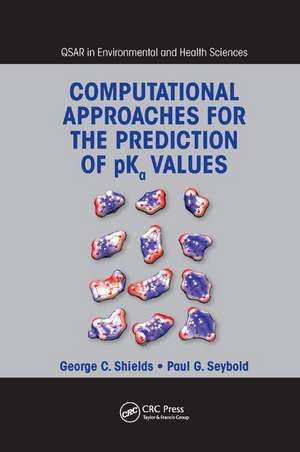Computational Approaches for the Prediction of pKa Values: QSAR in Environmental and Health Sciences
Autor George C. Shields, Paul G. Seybolden Limba Engleză Paperback – 18 oct 2017
Computational Approaches for the Prediction of pKa Values describes the insights that have been gained on the intrinsic and extrinsic features that influence a molecule’s acidity and discusses the computational methods developed to estimate acidity from a compound’s molecular structure. The authors examine the strengths and weaknesses of the theoretical techniques and show how they have been used to obtain information about the acidities of different classes of chemical compounds.
The book presents theoretical methods for both general and more specific applications, covering methods for various acids in aqueous solutions—including oxyacids and related compounds, nitrogen acids, inorganic acids, and excited-state acids—as well as acids in nonaqueous solvents. It also considers temperature effects, isotope effects, and other important factors that influence pKa. This book provides a resource for predicting pKa values and understanding the bases for these determinations, which can be helpful in designing better chemicals for future uses.
| Toate formatele și edițiile | Preț | Express |
|---|---|---|
| Paperback (1) | 456.63 lei 43-57 zile | |
| CRC Press – 18 oct 2017 | 456.63 lei 43-57 zile | |
| Hardback (1) | 1324.63 lei 43-57 zile | |
| CRC Press – 7 dec 2013 | 1324.63 lei 43-57 zile |
Preț: 456.63 lei
Preț vechi: 590.26 lei
-23% Nou
Puncte Express: 685
Preț estimativ în valută:
87.38€ • 91.46$ • 72.72£
87.38€ • 91.46$ • 72.72£
Carte tipărită la comandă
Livrare economică 31 martie-14 aprilie
Preluare comenzi: 021 569.72.76
Specificații
ISBN-13: 9781138199910
ISBN-10: 1138199915
Pagini: 175
Ilustrații: 25
Dimensiuni: 156 x 234 mm
Greutate: 0.45 kg
Ediția:1
Editura: CRC Press
Colecția CRC Press
Seria QSAR in Environmental and Health Sciences
Locul publicării:Boca Raton, United States
ISBN-10: 1138199915
Pagini: 175
Ilustrații: 25
Dimensiuni: 156 x 234 mm
Greutate: 0.45 kg
Ediția:1
Editura: CRC Press
Colecția CRC Press
Seria QSAR in Environmental and Health Sciences
Locul publicării:Boca Raton, United States
Cuprins
Introduction. Absolute pKa Calculations. Relative pKa Calculations. Quantitative Structure-Acidity Methods. Oxyacids and Related Compounds. Nitrogen Acids. Additional Types of Acids. Acids in Nonaqueous Solvents. Additional Factors Influencing Acidity and Basicity. Conclusions. References.
Notă biografică
George Shields, Ph.D., is currently a professor of chemistry and dean of the College of Arts and Sciences at Bucknell University. His research uses computational chemistry to investigate atmospheric and biological chemistry.
Paul Seybold, Ph.D., has been has been a faculty member and department chair (1999–2004) in the Department of Chemistry at Wright State University in Ohio and a visiting scholar and visiting professor at a number of universities in the United States and Europe. His research interests center on chemical and biochemical applications of quantum chemistry, molecular structure-activity relationships, luminescence spectroscopy, and cellular automata models of complex systems.
Paul Seybold, Ph.D., has been has been a faculty member and department chair (1999–2004) in the Department of Chemistry at Wright State University in Ohio and a visiting scholar and visiting professor at a number of universities in the United States and Europe. His research interests center on chemical and biochemical applications of quantum chemistry, molecular structure-activity relationships, luminescence spectroscopy, and cellular automata models of complex systems.
Descriere
The acidity or basicity of a compound under various conditions is a crucial property for the action and detection of the compound as a drug, pollutant, or other active chemical agent. Thus, the ability to predict pKa values using theoretical methods is extremely useful. This book describes the insights that have been gained on the intrinsic and extrinsic features that influence a molecule’s acidity and examines the computational methods developed to estimate acidity from a compound’s molecular structure. It presents techniques for both general and specific applications.












